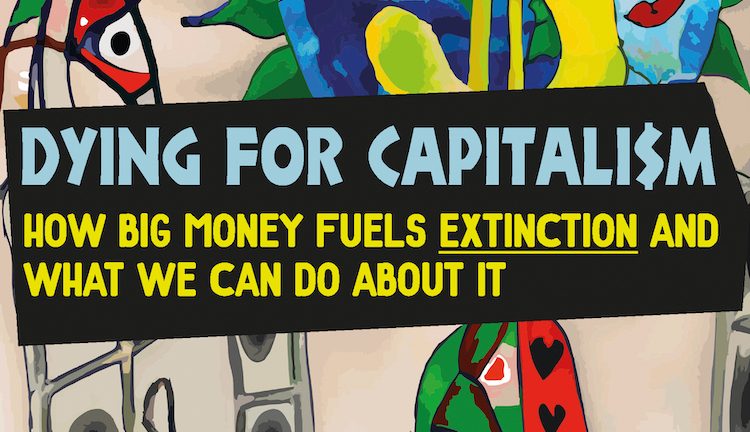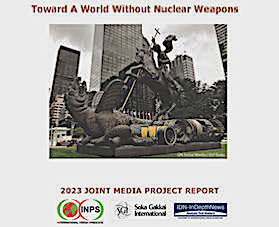By Charles Derber and Suren Moodliar*
Source: Globetrotter.
BOSTON, USA | 24 January 2024 (IDN) — The Cuban missile crisis of 1962 is etched into the minds of anyone old enough to experience the terror it triggered. For the first time, our leaders had ordered and succeeded in creating a military system that could destroy us all—and where there was and remains no possible way to survive the inevitable conflict.
The reasons for the pursuit of nuclear weapons are different than those publicly described and have little to do with deterring strikes from other countries. Instead, the nuclear program reflects a mad willingness to pursue global profit and power with force, even at the risk of extinction of all life on the planet.
This mad system remains today. It is even more dangerous now than during the Cold War. At the time of the Cuban missile crisis, nuclear weapons posed a threat to extinction that would likely destroy all life on the planet, today, prospects of general nuclear war are out of the headlines and largely out of our minds—even with the dangerous escalation of this threat focused on the Russian invasion of Ukraine in 2022.
Until Russia invaded Ukraine, recent wars seemed to many as less likely to become global nuclear wars and more limited or survivable conflicts—whether they were battles with smaller “jihadist” groups, trade wars, immigration battles, and culture wars internal to nations. With terrorism rather than a nuclear Soviet empire at the core of the Western security narrative, the argument has been that current threats—while very dangerous—can likely be managed without a massive nuclear conflagration.
This is a form of denialism by inattention and repressed fear, as well as elite-managed propaganda to help keep the public calm. It ignores the dangers posed by Western and non-Western development of nuclear arsenals, the breakdown of conventional and nuclear arms control treaties, perpetual U.S. wars to protect global power and profit, and the rise of a New Cold War era centered around direct or proxy conflicts with Russia and China, which can escalate over time into nuclear wars.
“A catastrophe waiting to happen”
Pointing to the need to focus anew on the extinction threat of nuclear war, famed Vietnam war whistleblower and high-level nuclear planner, the late Daniel Ellsberg, made clear in his 2017 work, The Doomsday Machine, that extinction by nuclear war is as great and probable a threat as during the Cold War between the United States and the Soviet Union when the world was much more focused on it:
“The hidden reality… is that for over 50 years, all-out thermonuclear war—an irreversible, unprecedented, and almost unimaginable calamity for civilization and most life on earth… [was and remains] a catastrophe waiting to happen.
No policies in human history have more deserved to be recognized as immoral. Or insane. The story of how this calamitous predicament came about and how and why it has persisted for over half a century is a chronicle of human madness.”
The madness Ellsberg describes has not ended. Two extinction threats arising from war exist and are growing today—and both are subject to continued denial. This is, in itself, madness, since denying the threats undercuts the ability to respond to them.
The first major threat is the view that the end of the Cold War and the collapse of the Soviet Union in 1991 have dramatically reduced the chance of a global nuclear war destroying life on the planet. This is an illusion partly because the Cold War has not completely ceased. The rivalry and tensions between the United States and Russia are evolving into a New Cold War, arguably more dangerous than the old one. Indeed, the growing competition and hostility between the United States and China is seen by several observers as eerily parallel to the Cold War between the United States and Russia.
“China threat,” a major security theme also of the Biden administration
The New Cold War can be seen in geopolitical rivalries and the breakdown or weakening of nuclear arms agreements that could quickly escalate political and military tensions in U.S.-Russia relations and, potentially, between the United States and China. The U.S. media and national security apparatus focus increasingly on the “China threat,” a major security theme of the Trump and Biden administrations.
This could bring the United States into conflict with Russia and China around East Asian and global economic and military security matters. In 2021, the Biden administration hit both Russia and China with sanctions for cyber hacking that signaled a hardening of conflicts with these nuclear rivals, both of which could escalate into extremely perilous military conflicts.
A multitude of other conflicts pit the United States against other Russian allies that could inflame the U.S.-Russian relationship, including conflicts in Iran, Venezuela, Crimea, Cuba, and Syria.
Moreover, border disputes between Eastern European and Baltic nations and Russia, disputes over the existence and purpose of NATO, and conflict over international trade are all dangerous issues that pit Russia and the United States against each other. These issues could escalate into a more severe crisis and war.
The depth of the New Cold War thinking became evident, ironically, when the Democratic Party and many liberal media elites, including progressive MSNBC hosts such as Rachel Maddow, attacked former President Donald Trump for “going soft” on Russia. The larger hidden story told by even more liberal news outlets is that Russia is a hostile, aggressive, and expansionary enemy of the United States and the “free world.” Defining Russia this way appeared to be how anti-Trumpists of all partisan persuasions felt they could gain legitimacy because it was the foreign policy bedrock view of the national security apparatus and the public.
The extinction threat invisibly grows as both political parties in the United States embrace the story of Russia’s antagonism and dangerousness. Nuclear crises could escalate in the South China Sea and East Asia, where China and Russia tend to be allied in opposing U.S. military and economic dominance. But the dangers of escalation and war with Russia could quickly emerge in places like Iran, where Russia (and nuclear China) both support Tehran. They may try to resist military provocations by the United States.
U.S. breaks its promise
Perhaps an even more significant nuclear threat lies on the Russia border, where Cold War tensions and NATO expansion have always been fuel for a significant firestorm between the United States and Russia. This began with the U.S. breaking its 1990 promise to the former President of the Soviet Union Mikhail Gorbachev not to advance NATO “one inch closer” to the Russian border.
This pledge was made in return for Gorbachev’s acceptance of a unified Germany aligned with the United States and Western Europe. The nuclear extinction threat is particularly dangerous and growing, as the U.S. seeks to deploy new nuclear and anti-ballistic weapons near the Russian border, partly in the name of a growing threat of border expansion by the Kremlin in Ukraine.
Between 2016 and 2019, the Trump administration essentially tore up the major nuclear arms agreements that appeared to be stabilizing the Russian-American nuclear relationship. President Joe Biden upped the ante by approving and funding further new “small” tactical or battlefield nukes, most likely to trigger a nuclear exchange on the Russian border.
President Biden has taken a far more adversarial stance toward Russia than Trump did, especially on issues ranging from Russian expansion of its borders to the suspected U.S. cyberattack on the Russian gas pipeline to Russia’s trade deals with the Europeans.
In 1963, the Cuban missile crisis made the specter of nuclear war an immediate threat. Anyone old enough to remember this also remembers the folly of “duck and cover” drills that falsely promised protection from a nuclear Holocaust. It was only because of diplomacy and a robust anti-nuclear movement that that threat receded for decades. Today, rampant militarism and leaders willing to take a chance on the fate of the world for economic advantage have, once again, ramped up the risk of nuclear annihilation.
As of January 23, 2024, the Bulletin of the Atomic Scientists has set the Doomsday Clock to 90 seconds to midnight, the closest it has ever been to a nuclear disaster. Our leaders now play a cynical game of “duck and cover” with the truth.
*This excerpt is adapted from Dying for Capitalism: How Big Money Fuels Extinction and What We Can Do About It, by Charles Derber and Suren Moodliar (Routledge, 2023), and produced for the web by Earth | Food | Life, a project of the Independent Media Institute.
Charles Derber is a professor of sociology at Boston College and has written 26 books. Most recently, he co-authored Dying for Capitalism: How Big Money Fuels Extinction and What We Can Do About It (Routledge, 2023). He is a contributor to the Observatory. Suren Moodliar is the editor of the journal Socialism and Democracy and coordinator of encuentro5, a movement-building space in downtown Boston. He is the coauthor of Dying for Capitalism: How Big Money Fuels Extinction and What We Can Do About It (Routledge, 2023). He is a contributor to the Observatory. [IDN-InDepthNews]
Photo: Book Cover Image













